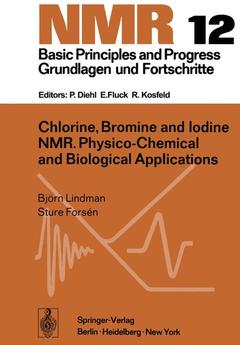Description
Chlorine, Bromine and Iodine NMR, Softcover reprint of the original 1st ed. 1976
Physico-Chemical and Biological Applications
NMR Basic Principles and Progress Series, Vol. 12
Authors: Lindman B., Forsen S.
Language: English
Subjects for Chlorine, Bromine and Iodine NMR:
Approximative price 84.35 €
Subject to availability at the publisher.
Add to cart
Chlorine, Bromine and Iodine NMR
Publication date: 10-1976
Publication date: 10-1976
Chlorine, Bromine and Iodine NMR
Publication date: 02-2012
372 p. · 17x24.4 cm · Paperback
Publication date: 02-2012
372 p. · 17x24.4 cm · Paperback
Description
/li>Contents
/li>
The increasing interest in NMR spectroscopy of what in some confer ences in this field is commonly termed "other nuclei" is unmistakable. Chemists and biologists who employ NMR spectroscopy to study their problems have, however, been somewhat reluctant to study nuclei with electric quadrupole moments. These nuclei frequently give rise to broad NMR signals, sometimes too broad to be detectable with ordinary high resolution NMR spectrometers. Spectrometers that could cope with broad NMR signals of low intensity, "wide-line" spectrometers, have been available since the mid 1950:s but it appears that most of these instruments ended up in physical laboratories where the research was primarily directed towards solid state problems. The study of quadrupolar nuclei can provide unique and very valuable information on a variety of physico-chemical and biological systems. For one thing the relaxation of quadrupolar nuclei is in many ways easier to interpret than the relaxation of non-quadrupolar nuclei, since the former is in many cases caused by purely intramolecular interactions modulated by the molecular motion. Studies of quadrupolar relaxation have therefore furnished important information about molec ular reorientation and association in liquids and have played - and will certainly play for many years - an important role in testing new theoretical models of molecular motion in liquids.
1. Introductory Aspects.- 1.1 General Properties of Halogens.- 1.2 Static Parameters.- 1.3 Dynamic Parameters.- 1.4 Chemical Exchange Effects.- 1.5 Experimental Aspects.- 2. Relaxation in Molecules or Ions With Covalently Bonded Halogens.- 2.1 Quadrupole Relaxation.- 2.2 Other Relaxation Mechanisms.- 3. Shielding Effects in Covalent Halogen Compounds.- 3.1 Theoretical Aspects.- 3.2 Experimental Data.- 3.3 Medium Effects on Halogen Shielding Constants.- 4. Scalar Spin Couplings.- 4.1 General Considerations.- 4.2 Experimental Data on Cl, Br and I Spin Couplings.- 5. Relaxation of Chloride, Bromide and Iodide Ions.- 5.1 Quadrupole Relaxation.- 5.2 Relaxation Rates and Chemical Shifts in Paramagnetic Systems.- 5.3 Chemical Exchange of Halide Ions.- 6. Shielding of Halide Ions.- 6.1 Absolute Shielding Values of Ions in Aqueous Solutions.- 6.2 Shielding in Aqueous Alkali Halide Solutions.- 6.3 Shielding in Other Aqueous Solutions.- 6.4 Shielding in Mixed Solvent and Non-Aqueous Solution.- 6.5 Water Solvent Isotope Effect on Shielding.- 7. Quadrupole Splittings in Liquid Crystals.- 7.1 General Aspects on Static Quadrupole Effects of Mesomorphous Systems.- 7.2 Halogen Quadrupole Splittings of Covalent Compounds in Liquid Crystals.- 7.3 Quadrupole Splittings of Halide Ions in Amphiphilic Mesophases.- 8. Halide Ions in Biological Systems.- 8.1 General Principles.- 8.2 Small Molecules or Ions of Biological Interest.- 8.3 Polypeptides.- 8.4 Proteins.- 8.5 Miscellaneous Systems.- 9. Studies of the Perchlorate Ion.- 9.1 Introduction.- 9.2 Shielding.- 9.3 Quadrupole Effects.- 10. Recent Work.- 11. References.- 12. Subject Index.
© 2024 LAVOISIER S.A.S.
These books may interest you

15N-NMR Spectroscopy 105.49 €

Solid State NMR 316.49 €

Annual Reports on NMR Spectroscopy 202.15 €

